Description
This species occurs in two forms. In the darker, more-common form, the forewing is reddish brown with the maculation (spots) sharply defined by dark-red lines. The medial area is similar in color to the remainder of the forewing and the postmedial line touches, or almost touches, the reniform spot. Superficially this form is most similar to Hypotrix hueco and Xestia bolteri , both of which occur with H. alamosa. It differs from X. bolteri in that H. alamosa has smaller reniform, orbicular, and claviform spots, and in lacking spiniform setae on the tibiae. The pale form of H. alamosa looks like the specimens have been bleached, so the forewing is light orange with the maculation weakly defined by fine yellow lines. The dark and light forms frequently occur together and the two syntypes of H. alamosa represent a specimen of each form.
Hexorthodes is a genus of moths of the family Noctuidae.

Hypotrix is a genus of moths of the family Noctuidae.
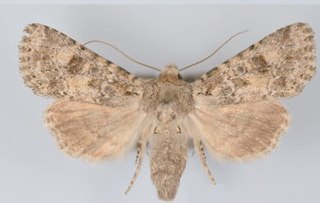
Aseptis catalina is a moth of the family Noctuidae first described by John Bernhardt Smith in 1899. It is found in the deserts of Arizona, California and Baja California in Mexico.

Hypotrix ocularis is a moth of the family Noctuidae. It is found from south-western New Mexico and south-eastern Arizona southward to Mexico City.
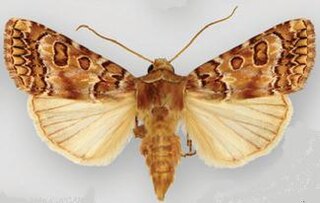
Hypotrix hueco is a moth of the family Noctuidae first described by William Barnes in 1904. It is known only from south-eastern Arizona in the United States.

Hypotrix lunata is a moth of the family Noctuidae. It is found in the range of Arizona to northern Mexico.
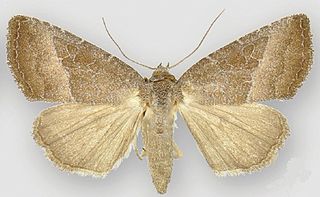
Ogdoconta cinereola, the common pinkband moth, is a moth in the family Noctuidae. It is found in eastern, central, and south-western North America. It occurs from southern Ontario and Quebec south to southern Florida. At the western edge of its distribution, it occurs from Manitoba southward through the Great Plains of Nebraska and Iowa, south throughout most of Texas, and westward through southern New Mexico to south-eastern Arizona. The distribution extends south to the state of Coahuila in northern Mexico.

Ogdoconta moreno is a moth in the family Noctuidae first described by William Barnes in 1907. It is only known from southern Arizona in the US, although its distribution likely extends into Mexico.

Ogdoconta satana is a moth in the family Noctuidae. It is found in western Texas and Carlsbad Caverns National Park in Eddy County, New Mexico. It is probably also present in Mexico.
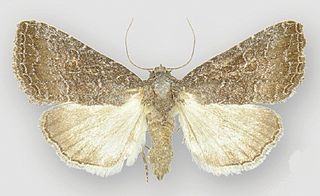
Ogdoconta tacna is a moth in the family Noctuidae first described by William Barnes in 1904. It is found in the US in central and south-eastern Texas. It is probably also present in Mexico.

Properigea albimacula is a small to medium-sized moth in the family Noctuidae first described by William Barnes and James Halliday McDunnough in 1912. It is found in the western US on the slopes of Cascades north of Oregon and almost throughout California. The wingspan is about 15 mm. Adults fly during the summer and are most common during July. This species is nocturnal and comes to lights.

Protorthodes incincta, the banded Quaker moth, is a moth in the family Noctuidae. It is found in North America, where it has been recorded in the western Great Plains and dry open forests of the Rocky Mountain region, with range extensions into the Great Basin, the American Southwest, and eastward in relict prairie areas into the Great Lakes region.

Protorthodes antennata is a moth in the family Noctuidae first described by William Barnes and James Halliday McDunnough in 1912. It has a small distribution in North America, extending from central Arizona to northernmost Mexico.

Aseptis fanatica is a moth of the family Noctuidae first described by Tomas Mustelin in 2006. It is found in western North America in Washington, Oregon, California, and Baja California Norte in Mexico. It is found in habitats like brush land and open forest in southern California, mostly at 1000–2000 meters, but occurs at lower elevations farther north.

Chaetaglaea rhonda is a moth in the family Noctuidae. In Canada, it is presently known only from dunes along the shore of Lake Huron in Lambton County, Ontario. In the United States, it is known from Carolina Beach State Park, New Hanover County, North Carolina. It is expected that the species occurs in suitable habitats up and down the Atlantic seaboard.

Austramathes purpurea is a species of moth in the family Noctuidae. It is endemic to New Zealand and can be found throughout the North and South Islands but has yet to be recorded at Stewart Island. It inhabits native forest. This species might possibly be confused with A. pessota, however this latter species does not have the purple hue to the forewings. The larvae of A. purpurea feed primarily on māhoe but have been recorded as feeding on, and have been reared on, narrow-leaved māhoe. The larvae pupate in a silken cocoon on moss covered ground. Adults can be found on the wing during the months of March to January but mainly occur during New Zealand's late autumn, winter, and spring. Light trapping may not be the most efficient technique for collecting this species.
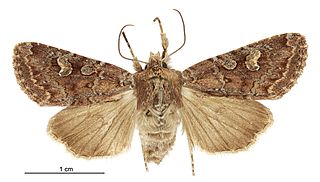
Ichneutica agorastis is a moth of the family Noctuidae. This species is endemic to New Zealand. This moth is similar in appearance to two other species in the genus but can be distinguished through the colour and size of its forewings. This species is found in the South Island and Stewart Island in open habitats in the subalpine zone. However in Southland I. agorastis can be found down to sea-level. Adult moths are on the wing between January and April. The life history and host species are unknown.

Ichneutica panda is a species of moth in the family Noctuidae. It is endemic to New Zealand and only found in central and southern parts of the South Island. The species has not been collected in Canterbury since the late 1950s and has not been seen at The Wilderness scientific reserve since 1941. This species is similar in appearance to Ichneutica falsidica however I. panda lack or have indistinct black dashes on their edge of their hindwings. I. panda inhabit shrubland from alpine zones down to river terraces and adults are on the wing between December to February. The life history of this species is unknown as is the host species of the larvae.

Ichneutica cana is a moth of the family Noctuidae. It is endemic to New Zealand.
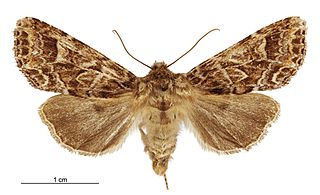
Ichneutica brunneosa is a moth of the family Noctuidae. This species is endemic to New Zealand. It can be found in the South Island from the Coromandel to Stewart Island. However it appears to not be present in the centre of the South Island. The distinctive colour and patterns on the forewing of this species ensures it is unlikely to be confused with similar species. It inhabits native forests with higher rainfall and is attracted to mercury vapour light traps. The life history of I. brunneosa is unknown as are the host species of its larvae but the adults of the species are on the wing from October to January.
This page is based on this
Wikipedia article Text is available under the
CC BY-SA 4.0 license; additional terms may apply.
Images, videos and audio are available under their respective licenses.



















